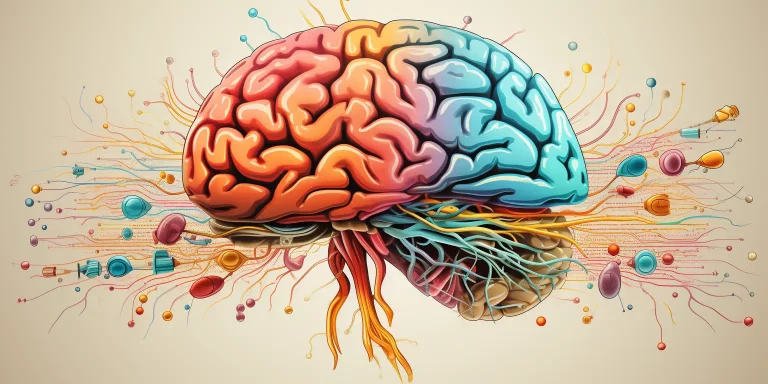Introduction
As one of the most commonly diagnosed neurodevelopment conditions, affecting both children and adults, ADHD is often viewed through a narrow lens – characterised primarily by hyperactivity and inattentiveness. But what if the core of ADHD lies deeper, rooted not just in attention, but in self-regulation and executive functioning? This compelling perspective forms the foundation of Dr. Russell A. Barkley’s Behavioural Disinhibition Theory of ADHD, a groundbreaking framework that has transformed our understanding of this complex condition. In this article, we will delve into the nuances of Barkley’s Behavioural Disinhibition Theory of ADHD, exploring its critical components, and its impact on shaping treatment and management strategies for millions of individuals living with ADHD. While we have based the information in this article on resources available online, it is worthwhile to remember that every ADHD individual’s experience is unique, and they should rely on professional guidance to assess their specific situation.
Before we go into the details, we’re glad to share that you can navigate the complexities of managing your day and supercharge your productivity by using Akiflow. Backed by Y Combinator, Akiflow is a time-blocking platform where everything can be viewed and managed in a single place without the hassle of switching between tabs and windows. Akiflow’s universal inbox lets you easily import all your tasks from your preferred tools into a single inbox. It is easy to create much more effective and realistic daily schedules by placing the inbox and calendar views side by side. You can lock time slots for your tasks and use Focus Mode to avoid multitasking and distractions. You can also monitor your daily performance with the Daily Planning and Daily Shutdown rituals. Click here to start a free trial.
Now, let’s dive in.
What is ADHD?
ADHD, or Attention Deficit Hyperactivity Disorder, is a neurodevelopmental condition that affects both children and adults. ADHD affects a person’s ability to focus, stay organized, and control impulses. According to the Centers for Disease Control and Prevention (CDC), the cause(s) for ADHD are unknown, but present research shows that genetics plays an important role. Recent studies also link genetic factors with ADHD. Understanding ADHD and its effective management can help individuals with ADHD to lead productive, fulfilling lives.
Who is Dr. Russell A. Barkley?
Dr. Russell A. Barkley is a renowned clinical psychologist, researcher, and educator, best known for his extensive work on ADHD and related conditions. He has earned several academic degrees, including a Ph.D. in Clinical Psychology, which positioned him as a leading expert in the field. Throughout his career, Dr. Barkley has dedicated himself to understanding, diagnosing, and treating ADHD, a condition affecting both children and adults in various aspects of their daily lives. One of Dr. Barkley’s most significant contribution to the field is his Behavioral Disinhibition Theory of ADHD.
What is Barkley’s behavioural disinhibition theory of ADHD?
Dr. Russell A. Barkley’s Behavioural Disinhibition Theory of ADHD posits that the primary issue in ADHD is a deficit in behavioural inhibition. According to this theory, individuals with ADHD have a core impairment in their ability to inhibit their behavior, which then leads to broader issues related to executive function, including working memory, emotional self-regulation, internalisation of speech, and reconstitution (planning and problem-solving). Here is a breakdown of the key components of Barkley’s theory:
- Behavioural Inhibition: At the root of Barkley’s theory is the belief that individuals with ADHD have a fundamental problem with inhibiting their behavior. This deficit in behavioural inhibition is thought to underlie many of the difficulties they experience.
- Deficits in Executive Functions: According to Barkley, this inability to inhibit behavior cascades into a series of impairments in executive functions, which are the mental processes that allow us to control our behavior and direct our actions toward a goal. These executive functions, according to Barkley, include:
- Non-verbal working memory: The ability to hold and manipulate visual images and other non-verbal information in mind.
- Verbal working memory: The ability to hold and manipulate verbal information in mind, which is crucial for self-regulation through internal speech.
- Emotion self-regulation: The ability to modify one’s emotional reactions.
- Planning and problem solving (reconstitution): The ability to analyze a situation, consider various possible responses, and choose and execute an appropriate response.
- Secondary Consequences: These deficits in behavioral inhibition and executive functioning can lead to secondary deficits in other areas of life. For example, individuals with ADHD may have difficulties with relationships, academic performance, occupational functioning, and may be more prone to accidents and injuries.
- ADHD as a Performance Disorder, not a Knowledge Disorder: Barkley emphasises that people with ADHD know what to do, but they struggle to do what they know because of their difficulties with behavioural inhibition and executive functioning. This is why ADHD is often described in this theory as a performance disorder rather than a knowledge disorder.
Barkley’s Behavioral Disinhibition Theory of ADHD places a central emphasis on difficulties with behavioral inhibition as the core of ADHD. This, in turn, leads to a cascade of issues with the executive functions that are necessary for self-regulation and goal-directed behavior, resulting in the various behavioral and functional impairments associated with the disorder. This theory has had a significant influence on how clinicians and researchers understand ADHD, and it has implications for the ways in which ADHD is treated and managed, emphasizing the importance of strategies that enhance self-regulation and executive functioning.
Impact of Barkley’s Theory of ADHD on treatment and management strategies
Barkley’s Behavioral Disinhibition Theory of ADHD has several important implications for the treatment and management of this disorder. Here are key ways in which this theory informs treatment and management strategies:
- Behavioral Interventions: Given the emphasis on behavioral disinhibition, treatments often involve behavioral interventions that aim to improve self-control and reduce impulsivity. These may include strategies such as positive reinforcement for exhibiting control, time-out strategies for impulsive behavior, and techniques to delay gratification.
- Executive Function Training: Based on Barkley’s theory, there is a focus on interventions that seek to improve executive functioning skills, such as working memory training, problem-solving strategies, and organizational skills training. For instance, therapists might work with clients on breaking tasks into smaller, more manageable steps and developing routines and schedules.
- Environmental Modifications: The theory suggests that individuals with ADHD may benefit from changes to their environment that reduce the need for self-regulation. This might involve creating more structured and predictable environments, both at home and in school or at work, that minimize distractions and make expectations clear. Using various productivity tools and digital planners, including Akiflow, can help those with ADHD navigate each day with greater ease.
- Parent and Teacher Training: Given the theory’s emphasis on the disorder as a developmental impairment of self-regulation, parent training (and teacher training, as appropriate) is often a significant component of treatment. This training is geared toward teaching adults strategies for managing and responding to the child’s behavior, reinforcing positive behaviors, and implementing consistent consequences for negative behaviors.
- Emotional Regulation Strategies: Given the emphasis on emotional self-regulation as a component of executive functioning in Barkley’s theory, treatments may also focus on strategies for managing emotions. This can include approaches such as cognitive-behavioral therapy (CBT), mindfulness, and relaxation techniques that are designed to help individuals with ADHD recognize, understand, and manage their emotional responses.
- Individualized Approaches: Barkley’s theory underscores the complexity of ADHD and the multiple domains of function that can be impacted. This suggests that effective treatment needs to be individualized and comprehensive, addressing not just attention and hyperactivity, but also issues related to working memory, emotion regulation, and other executive functions.
- Long-term Management Perspective: Given that the theory outlines ADHD as a chronic disorder of self-regulation and executive functioning, it informs the perspective that management strategies may need to be long-term and adaptive to the changing needs of individuals as they progress through different life stages.
Barkley’s Behavioral Disinhibition Theory of ADHD has been influential in shaping a comprehensive and multifaceted approach to the treatment and management of ADHD, focusing not only on core symptoms such as inattention and hyperactivity but also on the broader array of self-regulation and executive function deficits that are posited to underlie the disorder.
Key Takeaways
Dr. Russell A. Barkley’s Behavioural Disinhibition Theory of ADHD represents a pioneering perspective on understanding and addressing ADHD. This theory, rooted in the concept of behavioural inhibition as the core deficit in ADHD, has profound implications for how we perceive and treat this prevalent and complex disorder. Barkley’s theory argues that ADHD is not merely a problem of attention, but rather a disorder of self-regulation and executive function, predominantly stemming from deficits in behavioral inhibition. This perspective shifts the focus from symptom management to understanding and addressing the underlying issues affecting individuals with ADHD. The theory’s emphasis on executive functions – including non-verbal and verbal working memory, emotional self-regulation, and planning/problem-solving – provides a comprehensive framework for intervention. It encourages a holistic approach to treatment, advocating for targeted behavioural interventions, environmental modifications, parental and teacher training, and emotional regulation strategies. Moreover, Barkley’s theory underscores the chronic nature of ADHD, highlighting the need for long-term, adaptive, and individualised management strategies. As ADHD continues to be a significant concern worldwide, Barkley’s theory remains a pivotal guidepost in the quest for more effective and empathetic approaches to helping those who live with this condition navigate their daily lives more successfully and with greater ease.

Navigating Interruption Anxiety with ADHD
Discover key strategies for managing interruption anxiety in a digital world, focusing on structured environments, time management, and mindfulness to enhance productivity and well-being.

Organising Time with ADHD: A Comprehensive Guide to Calendar Use
Explore effective calendar use strategies tailored for individuals with ADHD. Learn how to harness the power of scheduling to overcome common time management challenges and enhance daily productivity.

ADHD Body Doubling: A Unique way to improve productivity
Discover ADHD Body Doubling: a distinctive productivity technique rooted in the power of human presence. Unveil its significance, especially for those with ADHD, and learn how it can reshape focus and task completion.

